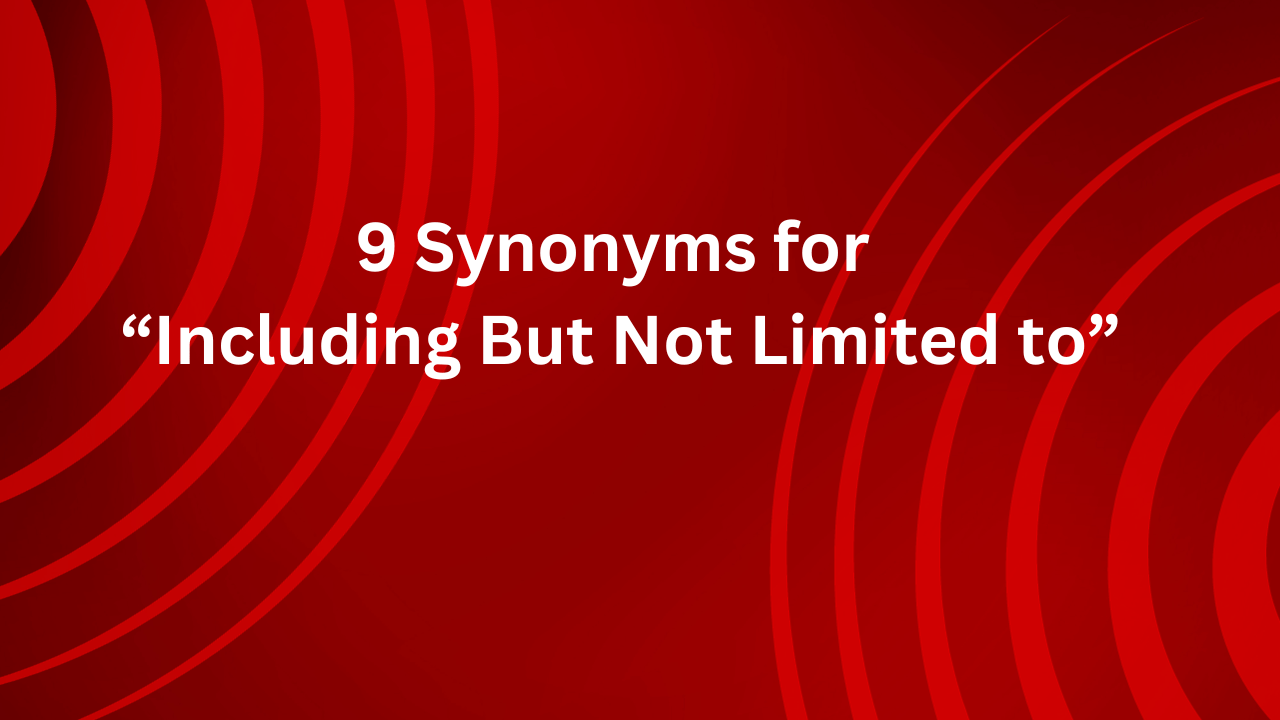Are you looking for a short synonym for “including but not limited to”? There are a number of effective alternatives, and we’re here to demonstrate their use.
Can You Say “Including But Not Limited to”?
You have the option of using “including but not limited to”, although this may seem somewhat redundant. In formal contexts, simply using “including” is often sufficient without the additional “but limited to.”
Advantages:
Accuracy: “Including but not limited to” provides a high level of accuracy, clearly stating that the items listed are not exhaustive.
Legal clarification: In legal documents, this phrase can be useful to avoid ambiguity and clearly define its scope.
Feature Emphasis: It effectively emphasizes specific elements within a larger category, ensuring a focused understanding.
Common Sense: Although somewhat formal, this is a recognized and widely understood phrase, reducing the potential for misinterpretation.
Cons:
Redundancy: The sentence can be seen as redundant, as “including” alone often indicates that the list is not complete.
Formality: In a more casual or everyday conversation, the extra “but not limited to” may seem overly formal and unnecessary.
Verbosity: The phrase is somewhat verbose, and in situations where brevity is necessary, it is better to choose a more concise expression.
Readability: Its formal nature can affect the overall readability of a document or communication, especially in contexts where brevity is valued.
Sure, let’s introduce a little variety, shall we? Varying the expressions you use is a smart way to keep your writing interesting, no matter the setting.
Here, we have compiled a list of the top 9 alternatives for “including but not limited to”. Continue reading to explore the options and choose the ones that resonate with you for integration into your emails.
Read this Post Also: 10 Best Alternatives Of “I Will Keep You Posted”
Synonyms for “Including But Not Limited to”

Incorporating:
Such as:
Among others:
To name a few:
Comprising:
Not to mention:
Including, but without limitation:
By way of illustration:
As an illustration:
Incorporating:
Inclusion serves as an effective alternative to “including but not limited to”. The term seamlessly integrates specific elements into a broad category, emphasizing their inclusiveness without being tiresome. Consider a scenario where different components of a project are being discussed:
“Within our project scope, we are covering critical aspects like budget allocation, timeline management, and client engagement.”
Here, “inclusion” expresses the deliberate inclusion of the mentioned elements, while maintaining a professional tone, while acknowledging the presence of additional ingredients beyond those clearly listed.
Such as:
The phrase “such as” provides a versatile and widely accepted way to introduce examples without the need for additional qualifiers such as “including but not limited to.” It provides clarity while leaving room for interpretation. Let’s explore its use in a workplace context:
“Several skills are essential to this role, such as project management, effective communication, and problem solving.”
In this example, “like” easily introduces specific skills without a list of restrictions, making it suitable for a variety of professional communications.
Among others:
“Among others” adds a significant touch to the counts, suggesting that the items listed are part of a more extensive collection. This is particularly effective when detailing different aspects within a category:
“Our team has expertise in a variety of areas including, among others, data analysis, strategic planning, and client relations.”
The term “among others” subtly suggests that there are clearly mentioned additional features, which promote a sense of inclusion.
To name a few:
“To name a few” provides a conversational yet professional tone, allowing the introduction of specific examples without an exhaustive list. Let’s explore its application in describing essential job responsibilities:
“As part of your role, responsibilities will include project management, client coordination, and, to name a few, quality assurance.”
Here, “to name a few” indicates that the responsibilities mentioned are exemplary rather than exhaustive.
Comprising:
“Includes” conveys a sense of inclusion and completeness, making it a suitable alternative to “including but not limited to”. Consider its use in outlining the components of a comprehensive strategy:
“Includes” conveys a sense of inclusion and completeness, making it a suitable alternative to “including but not limited to”. Consider its use in outlining the components of a comprehensive strategy:
“Comprehensive strategy includes market analysis, competitive research, and evaluation of customer feedback.”
In this context, “inclusive” emphasizes the comprehensive nature of the strategy while indicating the presence of additional elements.
Not to mention:
“Not to mention” provides a sophisticated way to introduce additional considerations without explicitly listing them. This phrase is effective in both formal and informal contexts:
“Our project success depends on effective communication, teamwork, and a commitment to innovation.”
The inclusion of “not to mention” means that innovation is only one aspect among various other important factors.
Including, but without limitation:
This sentence maintains the essence of comprehensiveness while clearly emphasizing that the list is not exhaustive. It is suitable for contexts where a legal or definitive explanation is required:
“The Agreement contains various clauses, including, but not limited to, indemnification, confidentiality, and termination.”
Here, “including, but without limitation” ensures that specific clauses are part of the contract while acknowledging the possibility of additional clauses.
By way of illustration:
“For example” combines formality with clarity, allowing the introduction of examples while maintaining a professional tone. Let’s explore its application in a presentation context:
“Our marketing strategy includes multiple components, for example, social media campaigns, influencer partnerships, and targeted advertising.”
Here, “for example” indicates that the aforementioned components serve as illustrative examples within a broader strategy.
As an illustration:
“For example” mirrors “for example” and is especially effective in formal or educational settings. It introduces examples without complete enumeration:
“The research findings indicate a number of trends in consumer behavior, for example, online shopping and an increased preference for environmentally friendly products.”
In this case, “as an example” indicates that the trends referenced are representative examples rather than an exhaustive list.
FAQs:
What does “Including But Not Limited to” mean?
“Including but not limited to” is a legal and formal way of stating that the list provided is not exhaustive and that other items or elements may be considered.
Why use synonyms for “Including But Not Limited to”?
Using synonyms adds variety to your language and helps avoid repetition in documents or communications. It also enhances clarity and professionalism.
Are there any specific contexts where these synonyms are commonly used?
Yes, these synonyms are often used in legal documents, contracts, academic texts, and formal communications where accuracy and completeness are important.
Can these synonyms be used interchangeably?
While they convey the same meaning, context must be considered. Some synonyms may be more appropriate for certain situations, so it is advisable to choose one that suits the tone and formality of your document.
Is there a preferred synonym for a particular context?
Not necessary. Choosing a synonym depends on personal preference, style guidelines, or the nature of the document. It is important to maintain consistency at all times.
Conclusion:
Finally, the phrase “including but not limited to” and its synonyms play an important role in legal and formal writing by indicating that the list is not exhaustive. This linguistic device adds flexibility and clarity to documents, allowing for more comprehensive interpretation.
Whether you choose “such as,” “for example,” or other synonyms, understanding their subtle uses can significantly increase your ability to convey information accurately and professionally. .
As language continues to evolve, adopting these alternatives ensures effective communication in different contexts.










